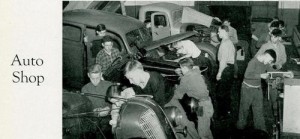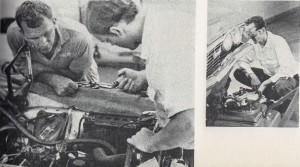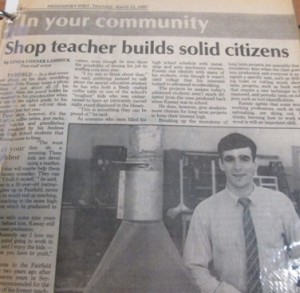By Kevin Preciado
with Phil Salvatti
A few years ago, my former High School Auto Shop teacher and I were talking about manufacturing automotive products in America. As I recall back in 1978 our local high school had a full industrial arts department. Something that was quite common all throughout America back in the day. Important for everyday knowledge and in many cases the open doors for many trades. Example, the following listed below are the classes that were offered where I had attended.
Vocational Auto Shop 1-2 & 3-4. Which was the top tier automotive class that educated students to perform engine rebuilds, from hot tanking a block to sizing/balancing connecting rods, boring & honing cylinders, turning crankshafts, decking blocks & heads, knuriling valve guides, facing valves & seats.
Advanced Auto Shop where one performed brake jobs, carb rebuilds, electrical diagnosis, cooling system service etc, 
Beginning Auto Shop where a student is introduced to 2& 4 cycle engines, operation and failure, diagnosis & repair.
Stay with me, I’m making a point here…
Machine Shop: introduction to blue print reading, measuring tools, files, metal lathes, dykem, Bridgeport style vertical mills, cutting tools, end mills, spot facing tools, fly cutters,
Taps & Dies. Projects included tack hammers to machining complete automotive projects.
Wood shop:
Similar to machine shop, but with wood,
Albeit with planers and joiners were used as well, routers, finger joints etc, any projects from address boards to custom built skate boards and hope chests were built in that class.
Metal shop:
Now here is one where I was really interested in and should have paid even more attention.
This was a very interesting class. We dealt with many different alloys and metals. Learned to braze, arc, mig & tig weld. Did some metal casting and learned how many products we use everyday were made.
Electrical:
This class dealt with everyday electronics which had progressed to solid state instead of vacuum tubes by this time, fixed many a TV and transistor radio while in this class, learned about alternating and direct current, multi meters, types and gauge of electrical wire. “Wasn’t one of my faves but learned a lot…that I used everyday since that class”.
Lastly…Drafting:
OMG, where do I begin here? Without a drawing, nothing could ever be mass produced, from cylinder heads, quick changes to houses, commercial buildings & even educational institutions.
This class I liked and use most of what I learned whenever I’m working on an important project.
Many types of tools were used in this class, some produced locally.
Ok. Here’s the point…
It is of most importance that these classes remain in our children’s high school curriculum. The disappearance of manufacturing in America in general says a lot. Not teaching, engaging or inspiring the minds and the talent of our kids in American high schools industry is tragic.
 History has already shown us what can be accomplished in a garage with concepts, inspiration, garnered knowledge, the basic teachings that these types of curriculum’s spawn. It happened with hot rods and racing from the 1920’-80’s. It also happened in the tech world, ie; Apples Steve Jobs and Steve Walzniak, as did many out in the silicon valley in the 80’s. It is also the same story for jazz and rock n roll as many great musicians got their starts in high school music curriculum’s, which too are sadly disappearing. For this article however, we focus on cars and manufacturing. I know you get the point.
History has already shown us what can be accomplished in a garage with concepts, inspiration, garnered knowledge, the basic teachings that these types of curriculum’s spawn. It happened with hot rods and racing from the 1920’-80’s. It also happened in the tech world, ie; Apples Steve Jobs and Steve Walzniak, as did many out in the silicon valley in the 80’s. It is also the same story for jazz and rock n roll as many great musicians got their starts in high school music curriculum’s, which too are sadly disappearing. For this article however, we focus on cars and manufacturing. I know you get the point.
Think of it this way. Today’s technology of complicated ICAD systems do make a product easier to bring to light. But how many schools teach these ICAD systems? And do they teach practical application together with ideas and design, like mention above in drafting?
A few years back, I spent several years donating my time to educate automotive students who I felt were not getting the education that they deserved. I watched as these kids who thought that “this must be the screw off class” light up and get excited as they learned the differences of disc & drum brake systems, suspensions, ride control, differentials, rack & pinion steering systems. These students actually began to like learning and wanted more. Many re-thought on what they might like to do after they graduated. It was all in how we presented it to them, by touching, feeling and working with these units instead of just dealing with theory.
I’ll close here. This past September the last of these classes were eliminated from everyday curriculum in the High School that both the editor of ROD WRITERS magazine /blog (Phil) and myself attended.
 Parents, grand parents, uncles, neighbors etc with kids around them… who remembers all this…Do them a favor. Currently our country is a industrially starved nation. Fight the schools and districts that these classes be brought back to every school in America. Give kids a chance over their creative, artistic, and industrial exploration and discovery. I-pads and tech tools and gadgets are great, but its not the whole picture.
Parents, grand parents, uncles, neighbors etc with kids around them… who remembers all this…Do them a favor. Currently our country is a industrially starved nation. Fight the schools and districts that these classes be brought back to every school in America. Give kids a chance over their creative, artistic, and industrial exploration and discovery. I-pads and tech tools and gadgets are great, but its not the whole picture.
Hi tech, together inside a full industrial arts package curriculum. They can truly build up themselves naturally, with a solid foundation, interest, encouragement, doing and creating a destiny that is befitting to them, before (if they can) step onto a college campus or not. Our future as a manufacturing country with good respectable nation building /world contributing jobs and products depends on it.
Fight to return these Industrial Arts to our children’s educational curriculum before other countries take the last of what we built away forever.







